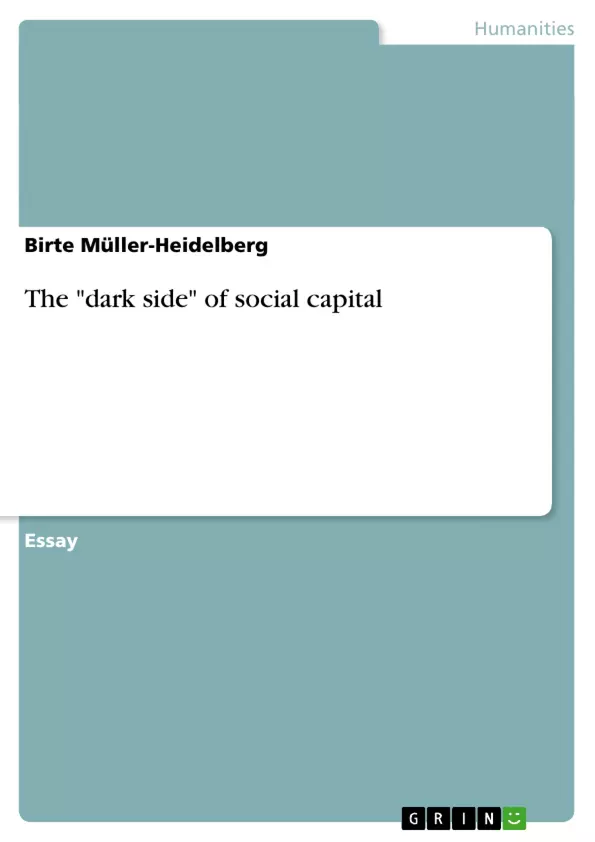Social Capital
“Such things as trust, the willingness and capacity to cooperate and coordinate,
the habit of contributing to a common effort even when noone is watching […].”1
1. Introduction
The idea of social capital that developed in sociology has in recent years spread all
over the disciplines and become more influential in politics and economics as well. It
is known to make economy flourish and increase the democratic performance of a
state. Social bonds lower the costs of working together, social capital facilitates cooperation.
People have the confidence to invest in collective activities, knowing that
others will also do so. With the rising interest in social capital, the concept has almost
been canonised. Social capital and the idea of civil society emerging from it often
appear as the cure-all to every single one of our problems.
The “features of social organisation, such as trust, norms, and networks, that can
improve the efficiency of society by facilitating coordinated actions”2 is how Putnam
defines social capital; and indeed, those factors seem very appealing. But a dense
concept of relations and trust, connectedness, networks and groups, the belief in
reciprocity and exchanges, common rules, norms and sanctions3 is not entirely
positive and harmless and therefore should not be embraced unquestioned. As every
other concept, social capital as well is a two edged sword. “Relationships matter”4, is
how Field summarizes the central thesis of the theory. And she is right. This essay
tries to show that in fact a whole range of different kinds of relationships do exist in
society, and that not all of them have a positive impact on the ‘common good’.
1 Solow, 2000, 7
2 Putnam, 1993, 169
3 central aspects of social capital as identified by Pretty/Ward, 2001
4 Field, 1996, 1
Inhaltsverzeichnis (Table of Contents)
- Introduction
- The rules of the game - Trust and networks
- Trust
- Networks
- The vicious cycle of exclusion - Social capital's dark side for individuals
- Networks
- Trust
- Rules and norms
- Blind trust and perverse networks - Social capital's negative impacts on the state
- Trust
- Networks
- Rules and norms
- Conclusion
Zielsetzung und Themenschwerpunkte (Objectives and Key Themes)
This essay aims to examine the concept of social capital, highlighting its potential benefits and drawbacks. It challenges the often uncritical acceptance of social capital as a solution to societal problems, arguing that its impact can be multifaceted and, in certain circumstances, detrimental. The essay explores the diverse relationships and networks that form within a society, emphasizing the crucial role of trust and reciprocity in shaping the effectiveness of social capital.
- The multifaceted nature of social capital and its potential for both positive and negative outcomes.
- The role of trust in fostering cooperation and facilitating coordinated action within society.
- The impact of social capital on the distribution of resources and opportunities, potentially reinforcing existing inequalities.
- The potential for social capital to support antisocial behavior and foster exclusion.
- The consequences of blind trust and perverse networks for the state and its ability to function effectively.
Zusammenfassung der Kapitel (Chapter Summaries)
- Introduction: This chapter introduces the concept of social capital and its growing influence in various fields. It highlights the potential benefits of social capital, such as economic growth and democratic performance, while also acknowledging its complex and potentially problematic nature. The chapter lays the groundwork for the essay's exploration of the diverse and sometimes negative impacts of social capital.
- The rules of the game - Trust and networks: This chapter delves into the fundamental elements of social capital: trust and networks. It discusses different forms of trust, including general trust in people, trust in reciprocity and exchanges, and trust in rules and norms. The chapter also explores the importance of networks in facilitating coordination, information sharing, and collective decision-making.
- The vicious cycle of exclusion - Social capital's dark side for the individual: This chapter examines the potential negative impacts of social capital on individuals. It highlights how social capital can reinforce inequality and contribute to the support of antisocial behavior. The chapter explores the role of networks in creating and maintaining exclusion, where individuals lacking the "right connections" are denied access to opportunities and resources.
Schlüsselwörter (Keywords)
This essay explores the complex concept of social capital, focusing on its key components: trust, networks, and rules. It delves into the potential benefits and drawbacks of social capital, examining its impact on both individuals and the state. The essay investigates the role of trust in fostering cooperation and facilitating coordinated action, while also analyzing the potential for social capital to reinforce inequality and support antisocial behavior. The essay explores the interplay between trust, networks, and rules, highlighting the potential for perverse outcomes when these elements are not carefully considered.
- Citar trabajo
- Birte Müller-Heidelberg (Autor), 2003, The "dark side" of social capital, Múnich, GRIN Verlag, https://www.grin.com/document/19652



